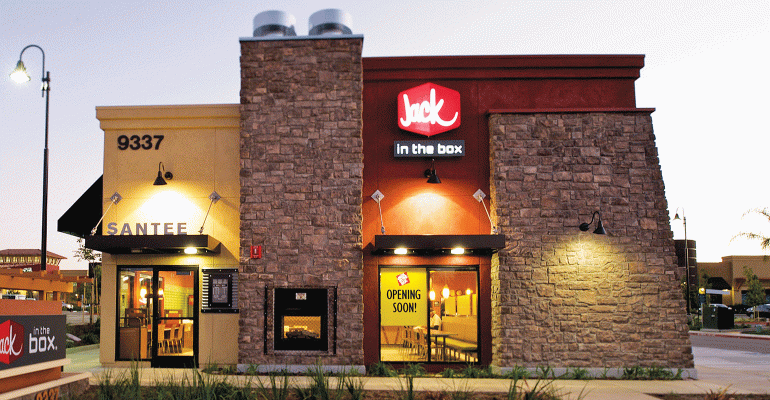Jack in the Box plans to balance premium and value offerings in the remainder of the year, the company said in a conference call discussing its performance for the first quarter of fiscal 2018, which ended Jan. 21.
The San Diego-based quick service chain reported net earnings of $12.2 million, or 41 cents per share for the quarter, down from $35.9 million, or $1.11 per share, a year earlier. That was on revenue of $294.5 million, down from $353.2 million.
Same-store sales were down systemwide by 0.2 percent, although the chain’s 255 company-owned stores saw an uptick of 0.2 percent, driven by average check growth of 2.6 percent. Number of transactions was down by 2.4 percent at those restaurants, the company said.
 CEO Leonard Comma said premium offerings — such as the All American Ribeye Burger (introduced in October and selling for $5.50 to $6.50 depending on the market), and tests of $4.99 “Food Truck Series” sandwiches including a Philly cheesesteak, a fried chicken bánh mì and a premium BLT — helped to drive sales, and so the company will continue “innovation in the high end.” However, Comma said that would be balanced with low-end options such as $2 breakfast pockets and value bundles, which Jack in the Box started promoting in the first quarter at prices ranging from $1 to $5.
CEO Leonard Comma said premium offerings — such as the All American Ribeye Burger (introduced in October and selling for $5.50 to $6.50 depending on the market), and tests of $4.99 “Food Truck Series” sandwiches including a Philly cheesesteak, a fried chicken bánh mì and a premium BLT — helped to drive sales, and so the company will continue “innovation in the high end.” However, Comma said that would be balanced with low-end options such as $2 breakfast pockets and value bundles, which Jack in the Box started promoting in the first quarter at prices ranging from $1 to $5.
“When we launch premium products well, that’s a transaction driver, and also a sales driver,” Comma said, adding that those items perform better than value offerings, and unlike discounted items, don’t hurt margins. He said value bundles are a better play for the chain than single discounted items, especially if they include items that Jack in the Box has that its competitors don’t, such as tacos.
He said consumers could expect “a healthy balance” of premium items and value bundles in the coming year.

All American Ribeye Burger
He added that, although transactions were down at company-owned locations by 2.4 percent, that was an improvement on the 5.4 percent decrease a year earlier.
He said the quick service market had been competitive and would remain so.
“We really can’t afford to take our foot off the gas.”
Meanwhile, the company would continue to refranchise its restaurants as it moved toward a more asset-light model. It refranchised 22 company-owned locations and opened one new company-owned restaurant during the quarter, closing out the period with 255 units. Franchises closed seven restaurants but opened five new ones, ending the quarter with 1,995 locations, making for 2,250 locations systemwide, down from 2,261 at the end of the first quarter of 2017.
The chain also would continue expanding delivery, which by the end of the quarter was available at “nearly 63 percent” of restaurants in the system.
Remodels would also continue over the next 4 years.
“We have around 600 restaurants that I kindly describe as ‘mature’,” and that required a refresh, Comma said.
The company’s earnings also included a $600,000 loss from Qdoba Mexican Eats, a chain that was being sold to Apollo Global Management LLC.
That sale is expected to close in April, Jack in the Box reported.
Looking to the second quarter, the chain predicted same store sales in the negative 1 percent to positive 1 percent range, and projected that comps would be positive in the 1 percent to 2 percent range for the year.
Contact Bret Thorn at [email protected]
Follow him on Twitter: @foodwriterdiary





